The death of Barbara Sargent of Howth after a short illness has taken from among us a much-loved and vivacious personality, whose warm family life was a heartening example of how the sea and sailing can be comfortably intertwined with shore interests of all kinds, and a very positive sense of community commitment.
Her enthusiasm was total. Although she and Gerry had celebrated their Golden Wedding Anniversary in April of this year, the passing of the years had in no way diminished her active involvement afloat, which continued to the end – she was racing the annual Howth Autumn League until its conclusion only a few weeks ago, and the huge turnout at her recent funeral was eloquent testimony to the many lives she had touched during a life lived to the full.
She was born Barbara Morgan to a family whose life in Howth was was much involved with the lifeboat service. Her father 'Onny' was the RNLI Station Manager for the port, which may sound like a professional position, but it was entirely voluntary, and from an early age lifeboat fund-raising was part of Barbara’s life, and remained so to the end.
In her childhood days, Howth was a decidedly primitive place for sailing of all kinds, and dinghy sailing was undertaken from the very workaday West Pier where the Howth Motor Yacht Club premises provided a rather limited base. Those young people without access to sailing dinghies could usually find a berth on larger craft by waiting in a group in a sort of “hiring fair” at the top of the steps where the HMYC outboard-powered dinghy acted as club tender, and one of Barbara’s earliest crewing tasks was aboard an International Dragon whose elderly owner had recruited her to ensure that his spectacles were regularly wiped clean while racing in rain and spray.
However, some far-sighted Howth sailors had appointed the young Rupert Jeffares to the completely new role of Junior Honorary Secretary, and he set about adding new classes to the small group of Heron dinghies which constituted the Howth Junior Fleet. Fireflies never quite made the grade, but the IDRA 14, which was already raced at Sutton and Clontarf, seemed to have more appeal, and some Howth-based IDRA 14s went north to make their debut at the IDRA Dinghy Week of 1962 at Skerries.
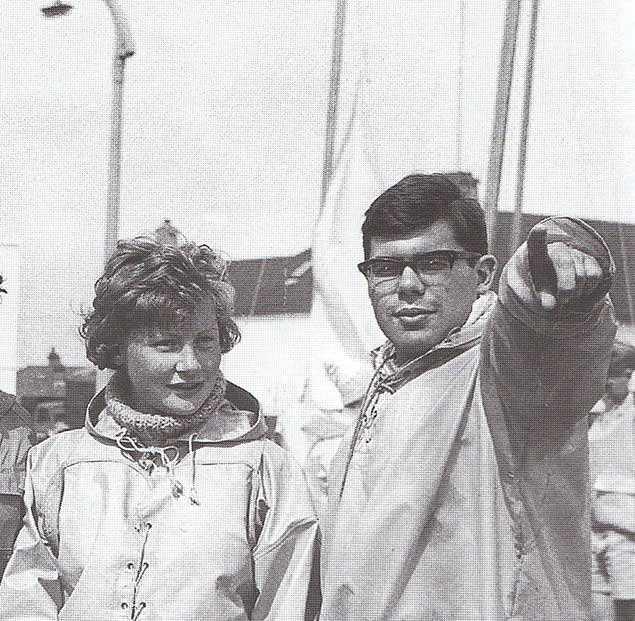 The young Barbara Morgan with Rupert Jeffares in the early days of Junior Sailing at Howth
The young Barbara Morgan with Rupert Jeffares in the early days of Junior Sailing at Howth
Rupert had signed on Barbara Morgan to be his crew in his own IDRA 14, and even though everyone lived on the same peninsula, this was the nascent Howth group’s first proper exposure to the high-powered IDRA 14 sailors of Clontarf and Sutton. In 1962, none was more high-powered than Gerry Sargent, as he was racing his brand-new own-built No 38 Starfish. He scored an impressive triple victory. He won the IDRA 14 class in the Dinghy Week. He won the Helmsman’s Championship at the end of the week, racing in Fireflies. And he won Barbara Morgan’s heart.
As their relationship developed during the mid-1960s, you’d have been hard put to say who was the keener of the two on boats and sailing. Barbara’s future father-in-law Charlie Sargent was an amateur boat-builder of such talent and skills - well beyond most professionals - that anyone who became involved with a member of his family was going to find that they soon were absorbing information about every aspect of boat-building, and everything to do with sailing boats.
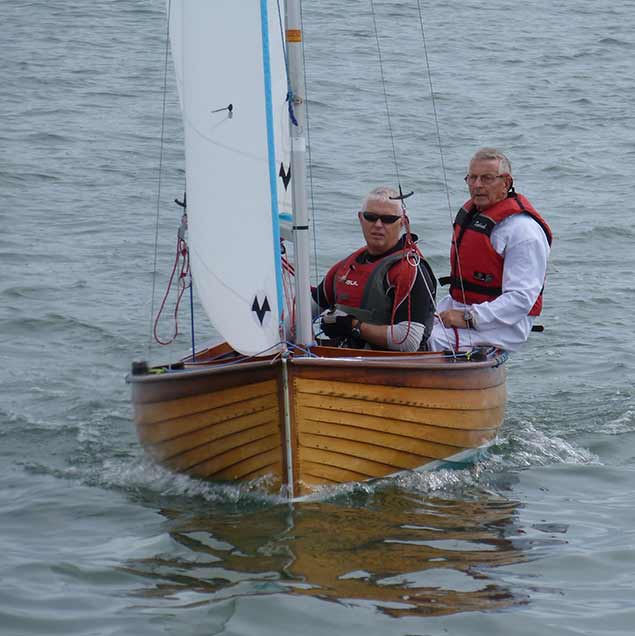 Gerry Sargent (crewed by Ian McCormack) sailing the IDRA 14 Starfish, which he built in 1962 when he won the class at Dinghy Week. This photo was taken at the IDRA 14s 70th Anniversary in Clontarf in September 2016, when he also won. Photo: W M Nixon
Gerry Sargent (crewed by Ian McCormack) sailing the IDRA 14 Starfish, which he built in 1962 when he won the class at Dinghy Week. This photo was taken at the IDRA 14s 70th Anniversary in Clontarf in September 2016, when he also won. Photo: W M Nixon
But as the team skills of the Sargent-Morgan duo developed, Barbara’s sailing enthusiasm easily matched that of Gerry, and they were formidable and successful competitors afloat, yet always ready to take on voluntary tasks and backroom work ashore, for that was in their DNA. And as well, Barbara’s links to Howth provided other sailing outlets, with crewing opportunities on the cruiser-racers of Johnny Pearson and Ross Courtney, with Ross being particularly generous in his willingness to lend his vintage Clyde 30 Brynoth to the young people and their friends for adventure sails round Lambay and out to the Kish.
With marriage in 1967, a family soon followed – the twins David and Robert, and then Andy fourteen months later. Gerry and Barbara were determined to live on the waterfront, so they were pioneers in the movement which established the south end of Baldoyle Creek as a rising area in the Dublin desirable property ratings, and the hospitality in the Sargent household, with its views over the sea to Portmarnock golf links and beyond to Lambay and Ireland’s Eye, made it the heart of an extraordinary maritime world.
As for their growing family, their care needs on Saturday afternoons, when their parents were determined to be racing the IDRA 14, were met with ingenious solutions. Gerry even provided Barbara with the option of a conversion kit to turn his small station wagon into a mobile crèche which could be parked next to the Race Officer at Sutton Dinghy Club in an era when shore starts were still the norm, it being understood that SDC’s Race Officiating duties included keeping an eye on the Sargent kids while their parents were out racing.
 Family sailing in Baldoyle Creek on the Mermaid restored by Gerry, with the new house in the background, Barbara on the helm, and young Andy on the right.
Family sailing in Baldoyle Creek on the Mermaid restored by Gerry, with the new house in the background, Barbara on the helm, and young Andy on the right.
As a concession to the needs of family sailing, Gerry restored an old Mermaid, Daphne No 6, and she lay to a drying mooring off the house in Baldoyle to provide a “floating kindergarten”. But soon the boys were making their own way in sailing as well as continuing to ship on board with their parents, and with their interest in keelboats growing, Gerry and Barbara found their sailing interest becoming increasingly focused on Howth Yacht Club, where it was a long-standing tradition that many of the leading members had started their sailing at the tidal clubs of Malahide, Clontarf and Sutton.
This meant that at much the same time, many of their friends from their most energetic dinghy racing days were now adding to the mixture of enthusiasm which made up the newly-constituted Howth Yacht Club which had been created from an amalgamation of Howth Sailing Club and Howth Motor Yacht Club, and in serving on committees and voluntary groups within the club, Gerry and Barbara were among old friends.
Thus it seemed natural that Gerry should be a member of the Howth Inshore Lifeboat Crew, while he and Barbara also organized a keenly anticipated Annual Boat Jumble to raise funds for the RNLI, which they supported in many other ways.
But Barbara’s organizational talents and capacity to convey enthusiasm and information were also revealed in an unexpected capacity back in the days when an Irish Boat Show was a viable annual proposition, and the thriving existence of the Irish Federation of Marine Industries was possible in a pre-globalisation era.
The Federation realised that it was essential that they have a properly-manned stand at the show to field a wide and endless litany of questions. But to find one person who covered the many requirements of the job profile seemed an impossible dream. It was Pat Murphy of Dinghy Supplies who suggested Barbara Sargent. He had met her and Gerry through dinghy racing in Clontarf and Sutton, and had been impressed by her calm capacity to get things done, allied with her special ability to communicate enthusiasm and information.
For many years she cheerfully and efficiently looked after the Industry’s stand at the Show, the engaging and helpful face of the industry, tireless in her work on the behalf of Irish boating in its broadest sense, a centre of calm, good sense, sound advice and accurate insight in the midst of the Boat Show whirl.
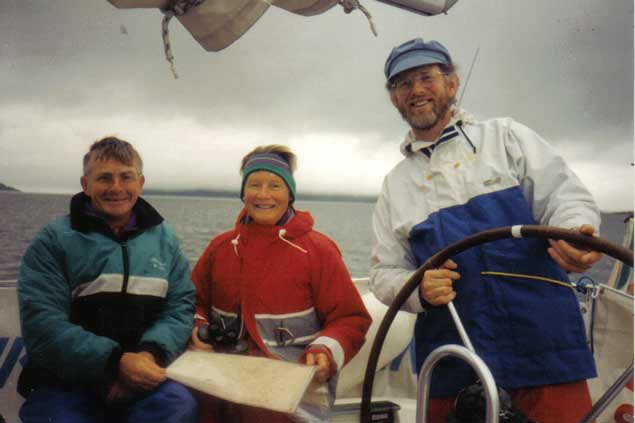 Gerry & Barbara Sargent with Pat Murphy on the Beneteau Genesis in Scotland in 1993. “They were a marvellous couple to cruise with” says Pat. “When you came into port, Gerry looked after all the warps while Barbara went quickly on ahead to find out what’s what and who’s who wherever you’d arrived”.
Gerry & Barbara Sargent with Pat Murphy on the Beneteau Genesis in Scotland in 1993. “They were a marvellous couple to cruise with” says Pat. “When you came into port, Gerry looked after all the warps while Barbara went quickly on ahead to find out what’s what and who’s who wherever you’d arrived”.
Yet while some would be happy to give the world of boats a brief rest after such a brief but concentrated annual period of work, Barbara would always be further enthused in joining Gerry in searching out their next dreamship, and by the early 1980s the Sargents were a formidable force in the rapidly-growing Squib class at Howth, with sons and their girl-friends equally involved.
Barbara raced and sailed Squibs with total relish, and would return to the class from time to time, but when the Puppeteer 22s began to catch on as yet another local One Design in Howth, the Sargents got involved there too, and in 1993 a watershed was reached when the Sargent family’s Puppeteer 22 Toucan – raced entirely by Barbara and Gerry and their sons – won every race of the season.
At the same time, the fact that Gerry and Barbara were very able seamen who were an asset in every crew meant they were much sought after by owners of cruiser-racers, particularly cruising owners with proper plans in place, and with people like Mungo Park with the Sigma 36 Black Pepper II, they were soon clocking up even more offshore miles.
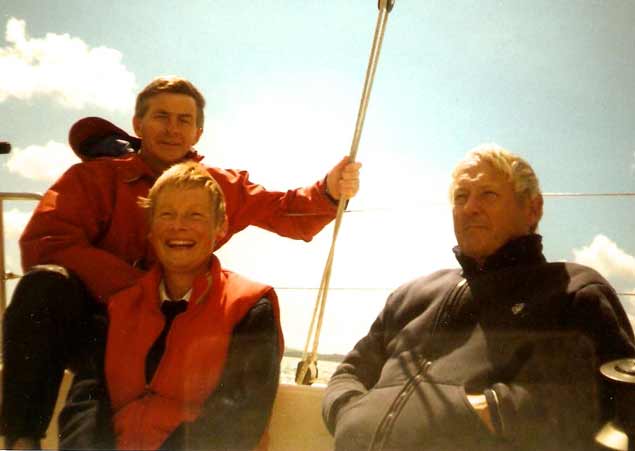 Gerry and Barbara with Mungo Park on his much-travelled Sigma 36 Black pepper II. Photo: Joe Phelan
Gerry and Barbara with Mungo Park on his much-travelled Sigma 36 Black pepper II. Photo: Joe Phelan
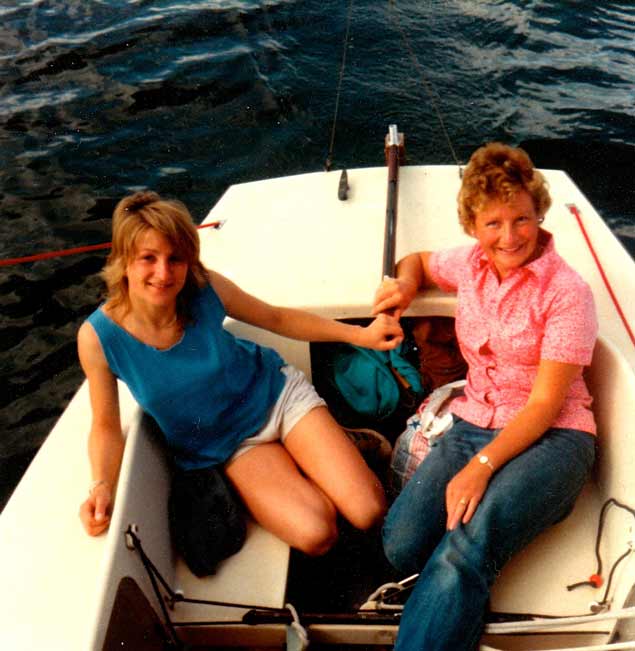 Barbara always enjoyed racing Squibs – in pre-lifejacket days, she is racing with Sandra Moody on Belfast Lough
Barbara always enjoyed racing Squibs – in pre-lifejacket days, she is racing with Sandra Moody on Belfast Lough
However, they felt that a change of pattern was necessary, so after 1993’s all-conquering year with Toucan, Gerry decided to give his energies to race administration while continuing to cruise with the occasional offshore race. But Barbara so loved the club racing scene that she signed on to the crew of Dermot Skehan’s regularly-raced MG 335 Toughnut, and for the next thirty years, until her final race in October 21st last, she was one of the cheerful band racing this vintage Castro design.
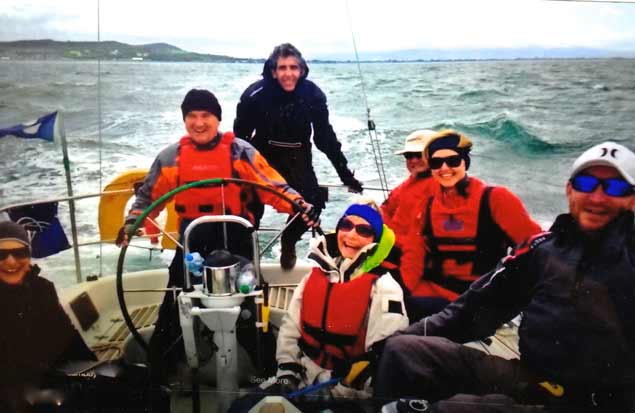 The gang’s all here. Having a blast on board Dermot Skehan’s MG 345 Toughnut, with Barbara at centre. She had her last race on this boat on October 21st
The gang’s all here. Having a blast on board Dermot Skehan’s MG 345 Toughnut, with Barbara at centre. She had her last race on this boat on October 21st
She and Gerry shared an exceptional ability to suss out a suitable boat for their own and other’s needs, and when Pat and Olivia Murphy were contemplating buying the 40ft Aldebaran for their proposed Round the World voyage, they persuaded Gerry and Barbara to come along for the first look-see in Mallorca. Initial impressions were good, particularly in the working part of the accommodation with emphasis on the galley, which Barbara subjected to minute analysis. But they wouldn’t say anything until they’d been sailing.
At sea, Barbara at first stayed below to sense how the ergonomics were all working, but then came on deck and went forward as sheets were trimmed to get the hefty big boat to give of her best. Pat and Olivia watched anxiously as Barbara, still without saying a word, paused to sense how the boat was performing. She waited for a while at the mast as Aldebaran drove on, dealing well with the irregular seas of the Mediterranean. Then she simply turned round and smiled and gave the thumbs-up to the anxious Murphys. They’d found their dreamship.
Although Gerry and Barbara always had invitations to bring their special combination of seaworthy talents to cruising ventures all over the world – many of which they accepted – they were convinced that they should have their own boat at home in Howth Marina as a matter of course, and they went through a number of interesting craft – which they would cruise as far as Kerry – until in 2003 they found the ideal, a Danish-built LM Vitesse 33 of 1989 vintage, an ingenious design which has real sailing ability, yet thanks to a very useful deckhouse, can provide an alternative interior steering position within an extremely comfortable and well-considered layout.
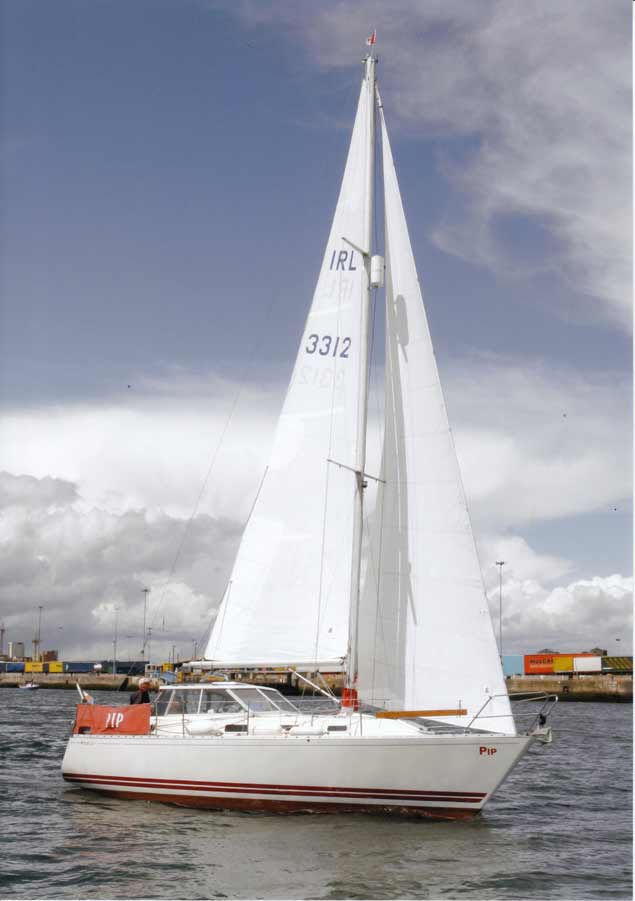 Gerry and Barbara Sargent’s Pip is an ideal boat for the Irish climate. She’s a Danish-built LM Vitesse 33, and is seen here during a visit to Poolbeg in Dublin. Photo: Barry O’Loughlin
Gerry and Barbara Sargent’s Pip is an ideal boat for the Irish climate. She’s a Danish-built LM Vitesse 33, and is seen here during a visit to Poolbeg in Dublin. Photo: Barry O’Loughlin
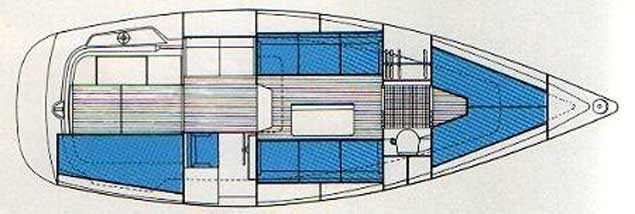 The accommodation layout on Pip – the chosen boat of a couple who knew their boats
The accommodation layout on Pip – the chosen boat of a couple who knew their boats
Called Pip, this interesting boat has been cruised to the far southwest, and throughout the Irish Sea. But with new generations of Sargents coming along, and with attractive invitations to cruise distant parts any time they felt like it, Gerry and Barbara realised that Pip gave best value mini-cruising on the waters close to home, meeting friends in familiar anchorages and always being there should a younger member of the extending family need a breath of sea air.
Thus in recent years they’d become experts on the coast of Fingal. Sail up round Lambay, and you’d almost invariably see Pip snugly anchored in a little cove which was sheltered in the wind of the day. Get the word that the mackerel are in, and invariably it would be Gerry and Barbara who would be first back to port with the earliest catch. See a nice breeze ruffling the blue waters of the Sound, and for sure Pip would be out there, enjoying it.
It was an idyllic existence to round out an extraordinary life not just in boats and sailing, but in the greater world of beloved family and cherished friends. It is impossible to convey fully the effective way in which Barbara Sargent lived, while at the same time indicating how her sometimes impish approach to life enlivened every gathering. The hundreds of us who attended her funeral – some from very far away - were privileged to share the private family farewell to someone who had been such a force for the good.
Our heartfelt condolences are with Gerry and their sons David, Robert and Andy and their wives and extended family, and their grand-daughters Joanna, Freya and Gemma, and particularly to grandson Jonny, who gave us such an eloquent and moving insight into how this great sailor also managed to be the perfect grandmother.
WMN
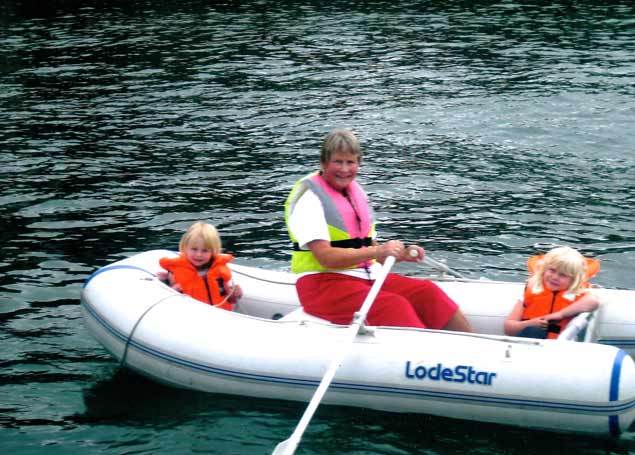 The great sailor was the perfect grandmother
The great sailor was the perfect grandmother































































